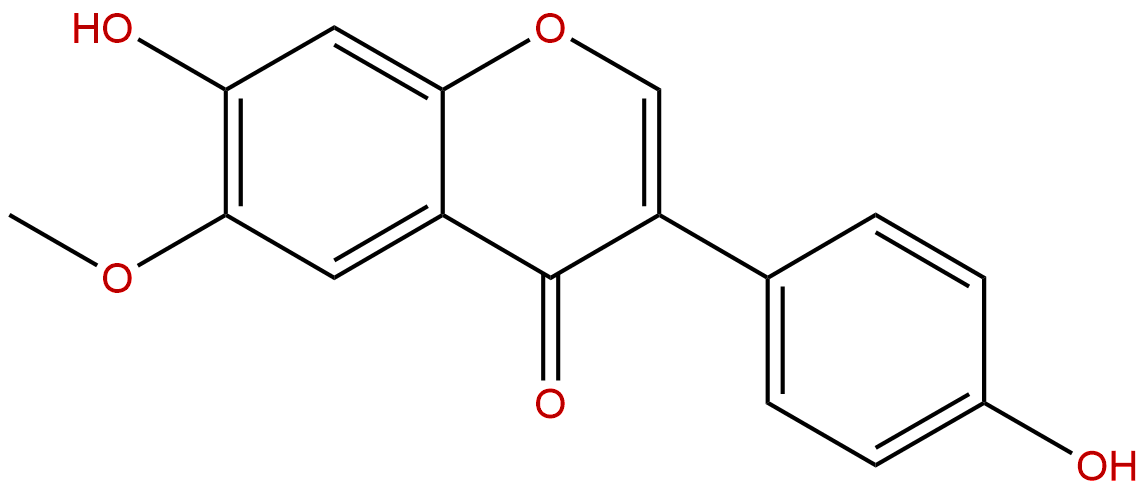
GlyciteinCAS No.:40957-83-3
|
||||||||||
 |
|
|
||||||||

| Catalogue No.: | BP0679 |
| Formula: | C16H12O5 |
| Mol Weight: | 284.267 |
Product name: Glycitein
Synonym name: 4′,7-Dihydroxy-6-methoxyisoflavone
Catalogue No.: BP0679
Cas No.: 40957-83-3
Formula: C16H12O5
Mol Weight: 284.267
Botanical Source: Centrosema haitense, Centrosema pubescens, Glycine max and Mildbraediodendron excelsa
Physical Description: Yellow Powder
Type of Compound: Flavonoids
Purity: 95%~99%
Analysis Method: HPLC-DAD or/and HPLC-ELSD
Identification Method: Mass, NMR
Packing: Brown vial or HDPE plastic bottle
Storage: Store in a well closed container, protected from air and light. Put into refrigerate or freeze for long term storage.
Whenever possible, you should prepare and use solutions on the same day. However, if you need to make up stock solutions in advance, we recommend that you store the solution as aliquots in tightly sealed vials at -20℃. Generally, these will be useable for up to two weeks.
The product could be supplied from milligrams to grams, up to kilograms
Inquire for bulk scale.
Descriptions:
Glycitein accounts for 5-10% of the total isoflavones in soy food products, has weak estrogenic activity, comparable to that of the other soy isoflavones but much lower than that of DES and 17beta-estradiol.[1]
Glycitein, daidzein and glenistein, with their inhibitory effects on natural and PDGF-BB-induced SMC proliferation, may be useful in attenuating such proliferation, a basic mechanism involved in atherosclerotic vascular change, thereby preventing atherosclerotic cardiovascular diseases.[2]
Glycitein has antioxidant effects, may suppress Abeta toxicity through combined antioxidative activity and inhibition of Abeta deposition, thus may have therapeutic potential for prevention of Abeta associated neurodegenerative disorders.[3]
Glycitein has inhibitory effects on hydrogen peroxide induced cell damage by scavenging reactive oxygen species and inhibiting c-Jun N-terminal kinase.[4]
Glycitein, the most potent activator of ERK1/2, decreases RWPE-1 cell proliferation by 40% ; it induces ERK1/2 activation was dependent, in part, on tyrosine kinase activity associated with vascular endothelial growth factor receptor (VEGFR). [5]
Glycitein suppresses PMA-induced phosphorylation of three types of MAP kinases, which are upstream signaling molecules in MMP gene expressions and NF-kappaB and AP-1 activities in glioma cells, therefore, the inhibition of MMP-3 and MMP-9 expression by glycitein may have therapeutic potential for controlling invasiveness of malignant gliomas.[6]
References:
[1] T. Song T, Suzanne Hendrich A, Murphy P A. J Agr Food Chem, 1999, 47(4):1607-10.
[2] Pan W, Ikeda K, Takebe M, et al. J Nut, 2001, 131(4):1154-8.
[3] Gutierrez-Zepeda A, Santell R, Wu Z, et al. Bmc Neurosci, 2004, 6(3):1-9.
[4] Kang K A, Zhang R, Piao M J, et al. Free Radical Res, 2007, 41(6):720-9.
[5] Clubbs E A, Bomser J A. J Nut Biochem, 2007, 18(8):525-32.
[6] Lee E J, Kim S Y, Hyun J W, et al. Chem Biol Interact, 2010, 185(1):18-24.
[7] César I D C, Braga F C, Vianna-Soares C D, et al. Rev.Bras.Farmacogn, 2007, 17(4):616-25.
HPLC of Glycitein
